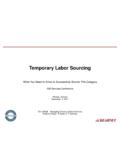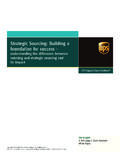Transcription of Developing and Implementing a Strategic Sourcing Strategy
1 Developing and Implementing a Strategic Sourcing Strategy CIPS has formulated positions on Strategic Sourcing as this is a key activity for purchasing and supply management professionals. Traditionally, Sourcing was considered to be the identification of new or potential suppliers. This is of course still a fundamental aspect of Strategic Sourcing but this practice document aims to illustrate how the function has developed and expanded in recent years. Introduction This document describes good practice purchasing and supply management; for many it will remain simply an aspiration; however CIPS encourages purchasing and supply management professionals to endeavour to move purchasing and supply management in their organisations towards Strategic Sourcing as described below. CIPS appreciates that some organisations are bound by legislative requirements that demand a different, (or in some cases, a complementary approach) to that proposed in this practice document; the public sector for example must comply with the EC Procurement Rules.
2 CIPS Positions on Practice CIPS views are stated through-out this practice document but the key statements are summarised below: CIPS considers Strategic Sourcing to be a pivotal activity for purchasing and supply management professionals. CIPS believes it is important to draw a distinction between Strategic , tactical and reactive Sourcing . CIPS considers that each organisation should as a priority develop an overall Sourcing Strategy , of which Strategic Sourcing should be seen as a key element. CIPS advocates the formation of a Sourcing Board or Panel for discussing strategies and assisting with decision-making. CIPS considers an 'As Is' analysis to be a key stage in the implementation of a Strategic Sourcing policy. Once the relevant data has been gathered and consolidated, and appropriate options generated, CIPS recommends that the outcomes be presented to senior management for their consideration.
3 In Developing , analysing and comparing a range of Strategic Sourcing options CIPS recommends the use of weighted evaluation criteria rather than simply using cost/price as the sole basis for arriving at a decision. Once the preferred Strategic Sourcing option has been finalised, CIPS believes that the purchasing and supply management function should have a key role to play in its implementation. CIPS believes that Strategic Sourcing options should be assessed in terms of the benefits which they actually deliver as opposed to those which they may have been expected to deliver as set out in the original business case. Categories of Sourcing : Reactive, Tactical And Strategic Reactive Sourcing CIPS defines reactive Sourcing as being the procurement approach where no proactive Sourcing strategies have been put in place and so the purchasing and supply management function has an entirely reactive role responding to requisitions or other unexpected requirements from the business.
4 CIPS encourages purchasing and supply management professionals to move away, wherever possible, from this type of Sourcing . However, some organisations still operate entirely on the basis of unexpected demand responding to individual needs as and when they arise. This response may be professional, but CIPS believes that such buyer behaviour is transactional, low level and will not necessarily enhance or promote the purchasing and supply management profession. Tactical Sourcing Tactical Sourcing is to some extent reactive as it covers those business requirements that cannot be planned in advance, but are provided within a framework of Strategic Sourcing . It is however, proactively managed and so resources and processes are set aside to manage it within the purchasing and supply management Strategy . An example of tactical Sourcing is working with colleagues in Marketing and Sales, providing a bid support activity within fast-moving technology areas.
5 Notwithstanding the above, CIPS suggests that there should be no unplanned or unexpected capital expenditure as all organisations have capital investment plans which purchasing and supply management professionals should obtain and incorporate in the Strategic Sourcing Strategy . If an unexpected requirement is ad hoc, low risk and low value, purchasing and supply management professionals should not be involved with obtaining the requirement anyway. All low-value requirements should have been aggregated into call off contracts for use by end users; those that are low value, yet high risk, are precisely those that require Strategic Sourcing plans. Strategic Sourcing Strategic Sourcing is a core activity in purchasing and supply management. It is a complex commercial process requiring extensive knowledge and competence. It can be defined as satisfying business needs from markets via the proactive and planned analysis of supply markets and the selection of suppliers with the objective of delivering solutions to meet pre-determined and agreed business needs.
6 Developing the Strategic Sourcing Strategy is a fundamental part of the purchasing and supply management process. Strategic Sourcing is a logical process involving the application of tools by skilled, competent and knowledgeable people; however - Developing and Implementing Strategic Sourcing is a functional process. Since it is such a broad area, it is advisable to sub-divide the subject into a number of sections as follows. a) Positioning Purchasing and Supply Management for Strategic Sourcing CIPS strongly recommends that every purchasing and supply management function develops a written, and regularly updated, overall Strategy which states their objectives and activities over a given timeframe. The Strategic Sourcing activity should form one part of the overall purchasing and supply management Strategy . The first stage in Implementing Strategic Sourcing is the positioning of the purchasing and supply management function within the organisation.
7 In order to undertake Strategic Sourcing , purchasing and supply management must be positioned at the appropriate level (senior) within an organisation and should report to the Board (or via an appropriate Board representative) and it must possess suitable human resources. Strategic Sourcing requires the application and interpretation of sophisticated Strategic Sourcing tools and techniques such as relationship management, by suitably authorised and competent professionals. In order to sustain the high level position, resources and influence, CIPS recommends that purchasing and supply management professionals responsible for Strategic Sourcing create a suitable governance structure so as to: illustrate where the purchasing and supply management functions sits within the organisation alongside Finance, Legal, Human Resources illustrate the role of the function itself and those people that carry it out - the purchasing and supply management function's terms of reference, scope of responsibility and objectives.
8 CIPS also recommends that the purchasing and supply management function creates a Sourcing Board (sometimes referred to as a Procurement Board/Panel ) comprising, for instance, decision makers, opinion leaders and influencers. The Sourcing Board should be used to discuss strategies, policies, approaches, assist with decision making and to help influence others in the organisation on behalf of the purchasing and supply management professionals. b) As is Analysis The second, and very resource-consuming stage in Strategic Sourcing involves the As is analysis stage which includes: Customer and business requirements what do our customers need and what does the business need? Spend analysis historical usage analysis of goods or services supplier positioning supplier historical analysis transaction cost analysis critical nature of products. Future spend analysis forward/expected usage of goods and services trends in the market.
9 Market analysis assessment of the market capability analysis of power dependency in supply chains analysis of individual marketplaces supplier preferencing relative positioning of your organisation supply chain cost analysis the nature of the market - appropriate type osourcing Strategy - global, regional or local potential size (and actual size) of the supply base. Several analytical tools are appropriate for this stage including Porter's Five Forces, PEST (Political, Economic, Social, Technological) and SWOT (Strengths, Weaknesses, Opportunities and Threats). Further information on such tools is available from CIPS. c) Mapping Supply Chains The process of mapping supply chains can be complex and the extent to which it is undertaken is dependent on the value and risk of the procurement in question and limited by the resources allocated to Strategic Sourcing by the organisation.
10 The As-is analysis and Mapping stages can take typically between three and six months. CIPS recognises this timeframe is too long for some organisations and moreover impracticable for some procurement situations. However, the longer term benefits of such proactive Strategic Sourcing are invaluable. CIPS considers that good practice supply chain mapping includes: identifying profit and gross margins in supply chains understanding interdependencies in supply chains power dependency mapping the required products and services onto these supply chains analysing spend by each supplier in respect of category and business unit buying patterns by product, service, supplier, and business unit Sourcing patterns pricing patterns - both past and forecasted, and also purchase price analysis historical performance of suppliers historical market trends and associated cost drivers (there are specialists in various fields) value chain analysis identifying and addressing dominant players in the supply Developing and Implementing a Strategic Sourcing Strategy chain critical asset analysis ( identify your critical assets which should be borne in mind when out Sourcing )









